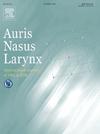青少年早发性听力损失人工耳蜗植入术的远期疗效
IF 1.5
4区 医学
Q2 OTORHINOLARYNGOLOGY
引用次数: 0
摘要
目的新生儿听力筛查(NHS)对人工耳蜗植入(CI)的预后有长期的有益影响;然而,一些青少年仍然需要CI评估,因为进行性听力损失。本研究旨在探讨青少年CI术后的长期影响,并确定预后因素。方法选取34例10岁后行CI治疗的重度至重度听力损失患者(青少年组)。将该组的术前和术后结果与138例10岁前接受CI治疗的重度至重度听力损失或舌旁听力损失患者(儿科组)进行比较。我们收集了听力损失诊断年龄、开始使用助听器(HA)年龄、CI年龄、术后观察时间、受影响侧和未受影响侧纯音听力阈值、术前(HA)和术后(CI)辅助听力水平、言语辨别评分(SDSs)和沟通模式等数据。基于术后SDS对青少年组CI的预后因素进行研究。在同意问卷调查的患者中,还评估了术后听力理解、发音、满意度和CI后的期望。结果青少年组植入助听器后助听阈值和SDS均有显著改善(p <;0.001),但这两个变量在青少年组都明显差于儿科组(p <;0.05)。术后SDS与术前SDS (ρ = 0.5056)和术前未患侧听力水平(ρ =−0.3864;p <;0.05)。两组间CI年龄、诊断年龄和HA开始使用年龄无显著差异。在青少年组中,听-言语交流模式的使用者得分最高,且在术前和术后因素上存在显著差异。问卷调查结果显示,青少年组术后听力和发音明显差(p <;0.05),但两组间CI后的满意度和期望值无显著差异。结论即使是听力损失的青少年,ci也能提供令人满意的长期结果。术前更好的SDS和听力可能对该年龄组CI的结果很重要。本文章由计算机程序翻译,如有差异,请以英文原文为准。
Long-term outcomes of cochlear implantation in adolescents with early-onset hearing loss
Objective
Neonatal hearing screening (NHS) has long-term beneficial effects on the outcomes of cochlear implantation (CI); however, some adolescents still require CI evaluation because of progressive hearing loss. This study aimed to investigate long-term postoperative effects and to identify prognostic factors in adolescents with CI.
Methods
Thirty-four patients with pre- or perilingual severe-to-profound hearing loss who underwent CI after the age of 10 years (adolescent group) were included. The pre- and postoperative outcomes of this group were compared with those of 138 patients with pre- or perilingual severe-to-profound hearing loss who underwent CI before the age of 10 years (pediatric group). We collected data on the age at diagnosis of hearing loss, age at initiating hearing aid (HA) use, age at CI, postoperative observation time, pure-tone hearing thresholds on the affected and unaffected sides, preoperative (HA) and postoperative (CI) aided hearing levels, speech discrimination scores (SDSs), and communication mode. The prognostic factors for CI in the adolescent group were investigated based on postoperative SDS. In patients who provided consent for a questionnaire survey, postoperative listening comprehension, articulation, satisfaction, and expectations after CI were also evaluated.
Results
In the adolescent group, significant improvements were noted in the aided hearing threshold and SDS after implantation (both p < 0.001) except for two cases, but both variables were significantly worse in the adolescent group than in the pediatric group (both p < 0.05). Postoperative SDS significantly correlated with preoperative SDS (ρ = 0.5056) and preoperative hearing level on the unaffected side (ρ = −0.3864; both p < 0.05). The age at CI, age at diagnosis, and age at initiating HA use were not significantly different between the two groups. In the adolescent group, users of the auditory–verbal communication mode scored the highest and showed significant differences in preoperative and postoperative factors. The questionnaire survey findings indicated that postoperative listening and articulation were significantly worse in the adolescent group (both p < 0.05), but satisfaction and expectations after CI did not significantly differ between the two groups.
Conclusion
CI appears to provide satisfactory long-term outcomes even among adolescents with hearing loss. Better preoperative SDS and hearing might be important for the outcomes of CI in this age group.
求助全文
通过发布文献求助,成功后即可免费获取论文全文。
去求助
来源期刊

Auris Nasus Larynx
医学-耳鼻喉科学
CiteScore
3.40
自引率
5.90%
发文量
169
审稿时长
30 days
期刊介绍:
The international journal Auris Nasus Larynx provides the opportunity for rapid, carefully reviewed publications concerning the fundamental and clinical aspects of otorhinolaryngology and related fields. This includes otology, neurotology, bronchoesophagology, laryngology, rhinology, allergology, head and neck medicine and oncologic surgery, maxillofacial and plastic surgery, audiology, speech science.
Original papers, short communications and original case reports can be submitted. Reviews on recent developments are invited regularly and Letters to the Editor commenting on papers or any aspect of Auris Nasus Larynx are welcomed.
Founded in 1973 and previously published by the Society for Promotion of International Otorhinolaryngology, the journal is now the official English-language journal of the Oto-Rhino-Laryngological Society of Japan, Inc. The aim of its new international Editorial Board is to make Auris Nasus Larynx an international forum for high quality research and clinical sciences.
 求助内容:
求助内容: 应助结果提醒方式:
应助结果提醒方式:


